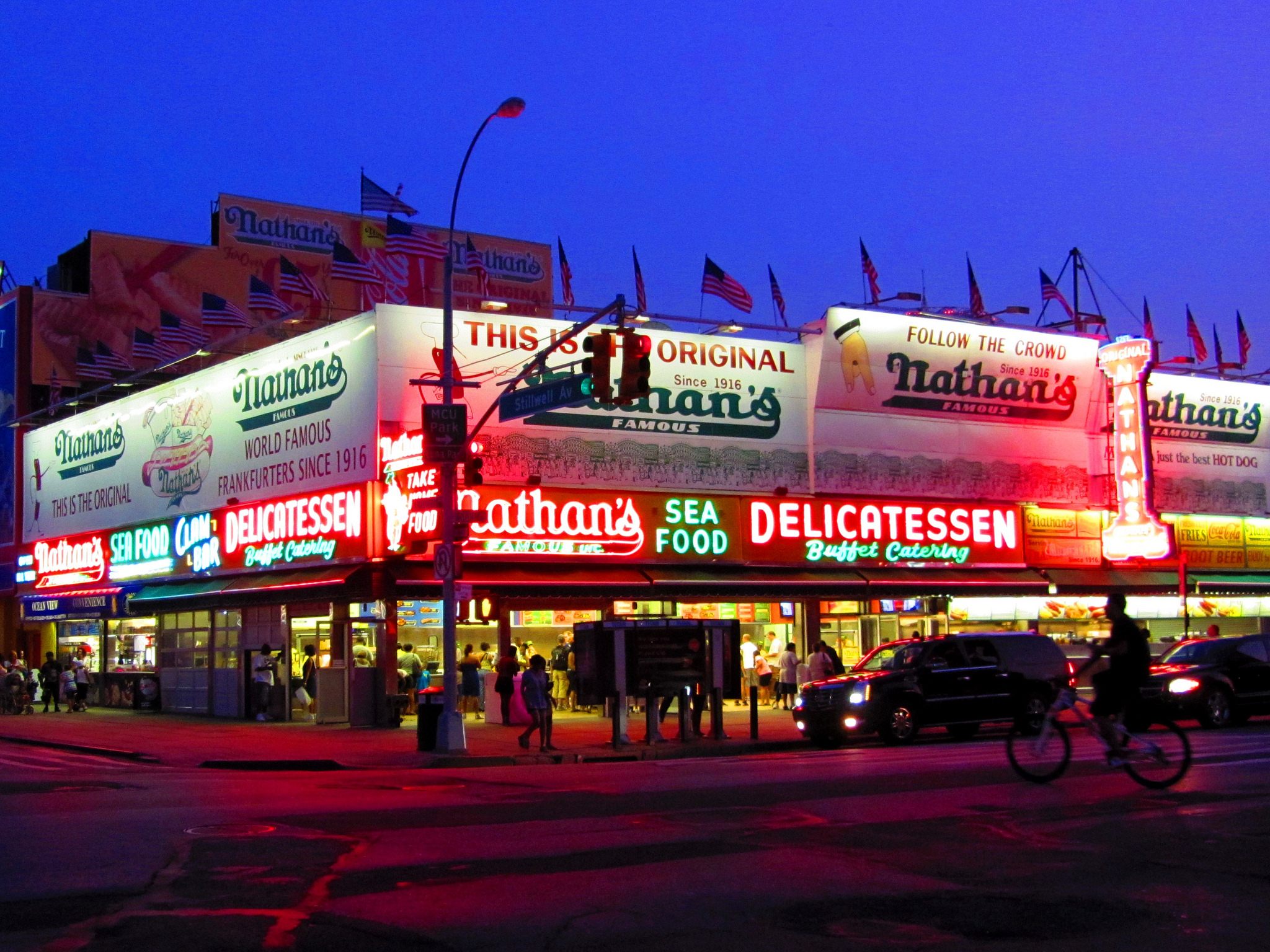Why Michigan’s Favorite Hot Dog Has a New York Name
How did Coney Island get to Detroit?

Detroit is hundreds of miles from the beaches of New York’s Coney Island. Yet the “coney dog” name can be seen advertising hot dog stands and restaurants city-wide. Detroit is the coney dog capital of the world, with hundreds of businesses devoted to selling them.
Understanding the makeup of a coney is the first step to figuring out how the name for a New York seaside resort came to describe a Midwestern hot dog. A coney dog is a hot dog in a steamed bun, coated in beanless chili with mustard and chopped onions. Coney fans can be forgiven for thinking that the chili-cheese atop their hot dogs has a Mexican origin. But according to Joe Grimm and Katherine Yung, authors of the 2012 book Coney Detroit, the sauce has its roots in spiced Greek red sauce. Which makes sense, because the first “Coney Islands,” in Detroit and beyond, were founded by Macedonian and Greek families almost a century ago.
In the early 1900s, Greek immigrants came to the United States in droves. A global economic crisis in 1893 and wars in Europe led almost a sixth of the Greek population to emigrate, mainly to Egypt and the United States.


Coney Island, in comparison, was booming. Americans had an insatiable appetite for fairs’ and exhibitions’ new foods, rides, and innovations such as the electric light. Many permanent pleasure parks put down stakes on Coney Island, and the massive seaside attraction soon ticked off all the boxes. It had the world’s first roller coaster (Switchback Railway, in 1884) and a park filled with more than a million electric lights (Dreamland, in 1904.) Plus, it kicked off the American craving for hot dogs.
Nathan’s Famous was founded in 1916, when Polish immigrant Nathan Handwerker set up shop on the Coney Island corner of Surf and Stillwell streets. Handwerker had worked for another hot dog purveyor down the street and slept on the kitchen floor to save money. When he opened, he sold hot dogs for half as much as his former employer.
At five cents each, the hot dogs quickly became a hit, and they became inextricably associated with Coney Island in popular culture. Yung says she and Grimm heard stories about how early Coney Island proprietors (sellers of hot dogs in Michigan, that is) came through New York’s Ellis Island. Greek immigrants who arrived in New York, before heading out west, likely heard of or tried Coney Island’s hot dogs, later hitting on them as a solid business.

But they probably weren’t picking up the name “hot dogs.” Handwerker himself didn’t like the name, preferring to call his product “frankfurters.” Legend even has it that the Coney Island Chamber of Commerce banned the word “hot dog” in 1913, fearing the “dog” connotation. (However, the Chamber of Commerce was founded in 1924.) Later, during wartime, calling sausages “frankfurters” might have seemed a little disloyal. (Confusingly enough, similar hot dogs in parts of New York state are now called “Michigans.”)
Regardless, when Greek immigrants arrived in Detroit, opening a Coney Island stand wasn’t just an option. Sometimes, it was the only option. “We know that when Greeks came to Detroit they were looking for work,” Grimm says. They weren’t the only ones. It was the beginning of Detroit’s automotive golden age, and people came from all corners seeking factory jobs. But for many Greek immigrants, there were both prejudices and a language barrier. “Some of them found they had to hire themselves,” Grimm says. Feeding a population of hungry factory workers turned out to be a concept with some legs.
One local family, Grimm and Yung say, made their fortunes off coneys. Two brothers, William and Constantine Keros, gave up sheep farming in Greece to move to Detroit. There, they opened Lafayette Coney Island in 1923. After a decade in business, the brothers quarreled. Constantine left, but he didn’t go far: He opened American Coney Island next door. Both restaurants are still there, selling coneys.

While the Keros brothers likely didn’t invent the coney (there were earlier restaurants), they were responsible for spreading the knowledge of how to operate a restaurant and cook Coney Island-style. “As Greek people got to Detroit, they had the instructions to go find the Keros family” for a job, says Grimm. It became a tool of economic empowerment for local Greeks, who became so numerous that a section of Detroit picked up the name Greektown. “As the pioneers in the coney culture became successful,” says Yung, “they sent for their relatives in Greece.”
Coney Island restaurants proliferated to the point that the term became a catch-all for “diner.” While many serve coneys, says Grimm, most are typical sit-downs, serving breakfast, sandwiches, and Mediterranean specialties. Once, Grimm says, he asked a restaurateur why he named his diner Coney Island, when he had no coneys on the menu. “So people will know it’s a restaurant,” the restaurateur replied.
These days, coneys are eaten across the nation. Some states have restaurants with century-long pedigrees, while others were founded by former Detroit residents. There are regional variations, such Flint, Michigan’s drier chili, sometimes made with beef heart. In Rhode Island, hot wieners are sold according to “the New York system,” sometimes also called “the Coney Island system.” Said system consists of the chef lining buns vertically up on his arm to fill them quicker. The spices and size are a little different, but they also have steamed buns, onions, mustard, and a meat sauce. Like the Detroit coney, New York System restaurants were often started by Greeks (and the occasional Macedonian). But in all cases, the combination of German sausage, Greek chili, and a New York name resulted in a hot dog culture that couldn’t be more American.
Gastro Obscura covers the world’s most wondrous food and drink.
Sign up for our regular newsletter.




























Follow us on Twitter to get the latest on the world's hidden wonders.
Like us on Facebook to get the latest on the world's hidden wonders.
Follow us on Twitter Like us on Facebook